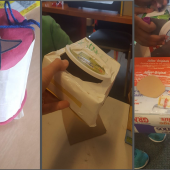
Abstract: This case study illustrates a cross-curricular learning experience, anchored in standards, where teachers and students actively engaged in co-constructed, inquiry-based learning and design thinking. The particular question this case study addressed was “How might students connect with environmental citizenship in authentic ways through media literacy experiences?” Specifically, the case study invited primary level learners to engage in a multimodal experience that was anchored in media literacy concepts and process. A pedagogical approach rooted in media literacy theory subsequently empowered students to make positive environmental changes in their communities and develop citizenship skills for the future. The project sought to develop awareness of sustainability through analysis, re-design, and production of snack food packaging. Educator reflections offer ideas for project improvement, such as producing for a wider audience, offering more choice, and making broader subject connections. This case study has implications for practice by demonstrating that, through various stages of scaffolding and integrated lesson design, young children are capable of applying sophisticated media literacy theory, inquiry, and design thinking to meet multiple curriculum standards.
Continue ReadingEat local. Choose a reusable bag instead of plastic. Put a brick in the toilet. These are intuitively simplistic environmental “solutions” that may do little but make a person feel environmentally virtuous. Energy and environmental science teaching requires us to change students’ preconceived simplistic notions about solving environmental issues if we want these future leaders to make real environmentally effective decisions. Students need to understand that the energy input in a disposable plastic bag is dwarfed by the energy expenditure of driving to the grocery store with a reusable bag, so that they don’t make symbolic, but ineffective decisions. One approach is to have students attempt to develop a “sustainable” product. The complexity of environmental solutions becomes evident when we have to evaluate the energy use and environmental consequences from raw material sourcing to reuse.
Continue Reading